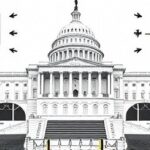As the U.S. government teeters on the brink of another shutdown, millions of low-income families face the harrowing prospect of delayed or missed SNAP benefits for November, potentially crippling their access to essential food assistance. With Congress failing to reach a budget agreement, the Supplemental Nutrition Assistance Program (SNAP)—a lifeline for over 41 million Americans—could see payments halted, exacerbating food insecurity at a time when inflation is already squeezing household budgets.
The threat comes as federal funding deadlines loom, with non-essential government operations set to cease if no deal is struck by midnight on Friday. According to the U.S. Department of Agriculture (USDA), SNAP benefits, which average about $250 per person monthly, support grocery spending that injects over $120 billion annually into the economy. A lapse could ripple through local economies, hitting supermarkets and farmers’ markets hardest.
SNAP Recipients Brace for Benefit Disruptions in November
For the 41 million Americans relying on SNAP benefits, the specter of a Government shutdown translates directly to uncertainty over their next meal. SNAP, formerly known as food stamps, provides critical food assistance to low-income households, the elderly, and disabled individuals. In fiscal year 2023, the program distributed $119 billion in benefits, enabling recipients to purchase nutritious groceries at authorized retailers nationwide.
During past shutdowns, such as the 35-day impasse in 2018-2019, SNAP benefits were temporarily protected through contingency funds, but experts warn that current reserves may not suffice for a prolonged November disruption. ‘This isn’t just about paperwork; it’s about families skipping meals,’ said Stacy Dean, USDA Under Secretary for Nutrition and Food Service, in a recent statement. Without timely funding, states could face delays in issuing Electronic Benefit Transfer (EBT) cards, leaving recipients unable to cover basic grocery spending.
Statistics paint a stark picture: About 20% of U.S. children live in households receiving SNAP, and disruptions could push child hunger rates higher. In urban centers like New York City, where over 1.8 million residents depend on the program, food pantries are already reporting a 15% uptick in demand due to anticipatory fears. Rural areas, too, are vulnerable; in states like Kentucky and Mississippi, SNAP accounts for up to 10% of local grocery spending, underscoring the program’s role in sustaining community food systems.
Personal stories highlight the human cost. Maria Gonzalez, a single mother of three in Chicago, shared with reporters, ‘SNAP is what keeps my kids from going to bed hungry. If benefits are late, I don’t know how we’ll make it—my part-time job barely covers rent.’ Such testimonials underscore the immediacy of the crisis, as families stockpile non-perishables in preparation for potential lapses.
Economic Shockwaves Hit Local Economies and Grocery Retailers
The Government shutdown‘s impact extends far beyond individual households, threatening to destabilize local economies dependent on SNAP-driven grocery spending. Economists estimate that every dollar in SNAP benefits generates $1.50 to $1.80 in economic activity, primarily through increased purchases at grocery stores, convenience marts, and farmers’ markets. A November delay could siphon up to $10 billion from monthly circulation, according to a preliminary analysis by the Center on Budget and Policy Priorities (CBPP).
Small businesses stand to lose the most. In food deserts—areas with limited access to fresh produce—SNAP recipients make up a significant portion of customer bases. For instance, a family-owned grocer in Detroit reported that 40% of its sales come from EBT transactions. ‘A shutdown means empty shelves and lost revenue; we’ve seen it before,’ owner Jamal Thompson told local news outlets. Nationally, the National Grocers Association has urged lawmakers to prioritize funding, warning of potential layoffs if the stalemate persists.
Broader economic indicators could suffer as well. The USDA’s Economic Research Service notes that SNAP injections help stabilize demand during downturns, preventing deeper recessions in agriculture and retail sectors. With inflation at 3.2% and grocery prices up 25% since 2019, a benefits lapse would amplify cost-of-living pressures, potentially increasing reliance on emergency food assistance programs like those run by Feeding America, which served 50 million meals last year alone.
State-level variations add complexity. California, home to 4.5 million SNAP participants, could see a $1.2 billion hit to its local economy, while Texas faces similar strains with 3.4 million enrollees. These disruptions might force states to dip into their own budgets for short-term aid, straining resources already stretched thin by natural disasters and pandemic recovery efforts.
- Key Economic Impacts: Reduced grocery spending leading to 5-10% sales drops in affected stores.
- Agricultural Effects: Lower demand for produce, potentially idling farms and increasing waste.
- Job Implications: Risk of 50,000 temporary layoffs in retail and food distribution if shutdown exceeds two weeks.
Political Standoff Fuels Shutdown Fears Among Lawmakers
At the heart of the crisis is a deepening political divide in Washington, where partisan disagreements over spending priorities have stalled budget negotiations. Republicans, pushing for cuts to non-defense programs, clash with Democrats advocating for expanded social safety nets, including protections for SNAP benefits. House Speaker Mike Johnson recently stated, ‘We must rein in wasteful spending, but families shouldn’t pay the price,’ yet no compromise has emerged.
The shutdown threat marks the fourth such brinkmanship in a decade, following impasses in 2013, 2018, and 2023. In the 2018 event, 800,000 federal workers went unpaid, and SNAP nearly exhausted its buffers, prompting emergency measures. This time, with midterm elections looming, the stakes feel higher. Senate Majority Leader Chuck Schumer accused opponents of ‘playing politics with people’s plates,’ while fiscal hawks like Sen. Rand Paul argue for ‘fiscal responsibility over endless entitlements.’
Behind the scenes, federal agencies are preparing contingencies. The USDA has instructed regional offices to prioritize SNAP processing, but legal experts say prolonged shutdowns could violate anti-deficiency laws, complicating fund reallocations. Advocacy groups like the Food Research & Action Center (FRAC) are mobilizing, with petitions garnering over 100,000 signatures calling for immediate resolution.
International observers note parallels to global fiscal crises, but domestically, the focus remains on averting humanitarian fallout. Bipartisan voices, including former President Barack Obama in a social media post, have called for unity: ‘Government shutdowns hurt real people—let’s get this done.’
Voices from the Ground: Families and Experts Sound the Alarm
Across the nation, the anxiety is palpable. In Atlanta, community organizers hosted forums where SNAP recipients voiced concerns about rising food costs compounded by potential benefit delays. ‘Food assistance isn’t a luxury; it’s survival,’ said Dr. Lisa Hamilton, a nutrition policy expert at Emory University. Her research shows that SNAP disruptions correlate with a 20% increase in emergency room visits for diet-related illnesses among low-income groups.
Quotes from affected stakeholders paint a vivid portrait. A veteran in rural Ohio, relying on SNAP for 70% of his grocery spending, remarked, ‘I’ve served my country; now the government can’t even ensure I eat? This shutdown is a betrayal.’ Economists like Mark Zandi of Moody’s Analytics warn of cascading effects: ‘A hit to local economies from reduced SNAP spending could shave 0.1% off GDP growth in Q4, at a time when recovery is fragile.’
Non-profits are stepping up. The National WIC Association, while focused on women, infants, and children, highlights overlaps with SNAP, estimating 8 million dual-eligible families at risk. In preparedness drills, food banks in Florida simulated a 30-day lapse, distributing 200,000 extra meals to bridge gaps. These efforts, however, can’t fully replace the structured support of federal food assistance.
Survey data from the Kaiser Family Foundation reveals 65% of SNAP households live paycheck-to-paycheck, with 30% reporting skipped meals in the past year due to funding uncertainties. As the deadline approaches, hotline calls to assistance centers have surged 40%, reflecting widespread dread over the Government shutdown‘s tangible consequences.
Pathways Forward: Averting Disaster and Securing Future Benefits
Looking ahead, resolution hinges on last-ditch talks, with a possible short-term funding bill offering a reprieve. Optimists point to precedents where crisis forged compromise, like the 2023 deal that averted a default. If enacted, such measures could restore SNAP funding retroactively, minimizing disruptions to November benefits.
Longer-term, experts advocate for reforms, including automatic contingency funding for essential programs like SNAP to insulate them from shutdowns. Bipartisan legislation proposed by Rep. Rosa DeLauro aims to codify these protections, potentially safeguarding $140 billion in annual food assistance. States are also innovating; programs in Oregon and Vermont have piloted local food hubs to buffer federal delays.
Yet, if the impasse drags into December, the fallout could deepen, with holiday grocery spending—often boosted by SNAP—plummeting and local economies facing prolonged slumps. Policymakers face mounting pressure from business lobbies and voter backlash, with polls showing 70% disapproval of shutdown tactics. As families hold their breath, the onus is on leaders to prioritize people over politics, ensuring that food assistance remains a steadfast pillar of American resilience.
In the interim, resources like the USDA’s SNAP hotline (1-800-221-5689) offer guidance, while community networks urge eligible individuals to apply early. The coming days will test the nation’s commitment to its most vulnerable, with the stakes—quite literally—on every dinner table.









